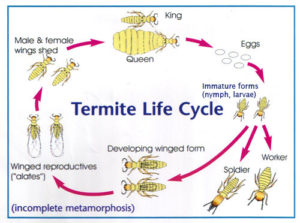Is it a Termite or a Winged Ant?
Is it a Termite or a Winged Ant?
Have you ever wondered if what you were seeing was a termite or just a flying ant? There are a couple of telltale ways to tell the difference.
- Both species have four wings, termite wings are uniform in size. The wings on ants are noticably larger in the front than the pair in the back.
- Termites antennae are straight whereas the ants antennae are elbowed.
- The wings of termites are twice as long as their body. Ant wings are shorter and more proportional to their bodies.
- One of the biggest differences is that ants appear distinctly segmented, because of their thin waist. Termites have a broad waist and are mostly a uniform width along their entire body.
Here’s a really good visual:
The life cycle of a termite:
The life cycle of a termite involves a developmental process called incomplete metamorphosis, beginning as an egg and then going through a series of nymph and adult stages. After the eggs hatch, they will experience three or four molting stages, first into workers, then later becoming soldiers or alate nymphs.
Some of these workers and nymphs have the potential to become supplementary reproductives and take over the roles of a king or queen. The development from nymph to adult can take months, depending on the conditions of the colony.
Termite swarming is caused by the nuptial flight of the alates. The males and females will pair up together and begin their search for a suitable place to build a colony. Once that place is found, the king and queen close up the entrance and proceed to mate. The pair will spend the rest of their lives in their nest, the queen eventually laying as many as 1,000 eggs a day. Depending on the species and the environment, the nuptial flights of subterranean termites may begin during different times of the year, mostly beginning in winter or spring, and sometimes influenced by weather conditions.
CLICK HERE and contact us today for prompt, professional service.


